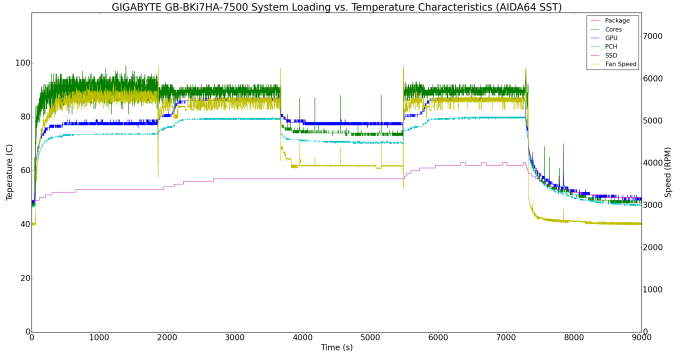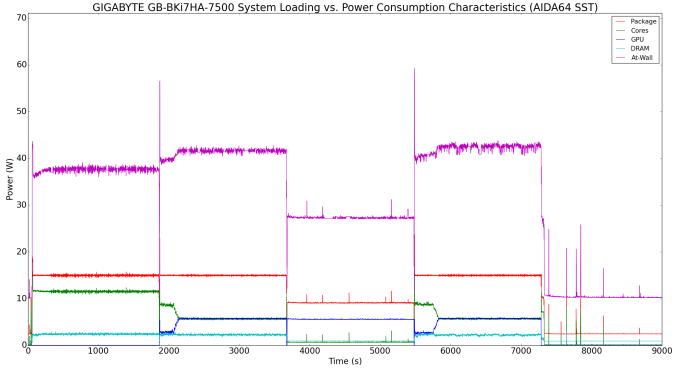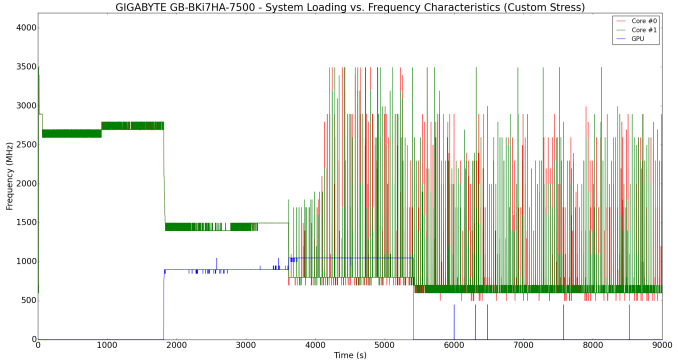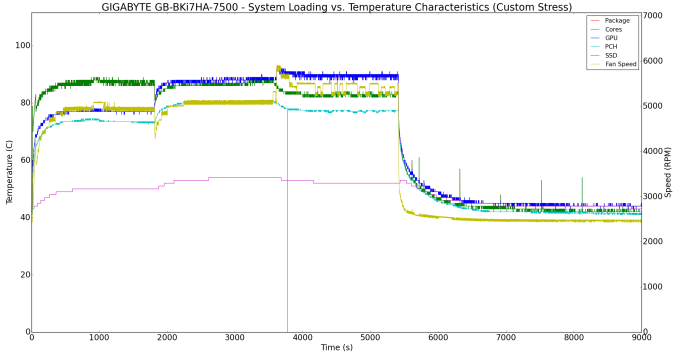GIGABYTE GB-BKi7HA-7500 Kaby Lake BRIX Review
by Ganesh T S on March 16, 2017 8:00 AM ESTPower Consumption and Thermal Performance
The power consumption at the wall was measured with a 1080p display being driven through the HDMI port. In the graphs below, we compare the idle and load power of the GIGABYTE GB-BKi7HA-7500 with other low power PCs evaluated before. For load power consumption, we ran the AIDA64 System Stability Test with various stress components, as well as our custom power virus test (a combination of Prime95 and Furmark) and noted the maximum sustained power consumption at the wall.


The idle power numbers are typical of a UCFF PC configured with a NVMe SSD. The sustained load power consumption is also similar to the Core i7-based units that we have evaluated before.
Our thermal stress routine starts with the system at idle, followed by four stages of different system loading profiles using the AIDA64 System Stability Test (each of 30 minutes duration). In the first stage, we stress the CPU, caches and RAM. In the second stage, we add the GPU to the above list. In the third stage, we stress the GPU standalone. In the final stage, we stress all the system components (including the disks). Beyond this, we leave the unit idle in order to determine how quickly the various temperatures in the system can come back to normal idling range. The various clocks, temperatures and power consumption numbers for the system during the above routine are presented in the graphs below. The important things to note include the core temperature steering well below the maximum junction temperature, and the chassis / thermal design being able to easily handle the specified 15W package power without throttling.
We repeated the same observations with our legacy stress test using the latest versions of Prime95 and Furmark - Prime95 v28.10 for 30 minutes (after launching with the max. stress option), followed by Furmark v1.18.20 for 30 minutes. The Prime95 load is then removed, allowing just the GPU alone to be stressed for 30 minutes. The system is then left idle.
According to the official specifications, the junction temperature of the Core i7-7500U is 100 C. Despite our power virus test being quite stressful, the thermal solution is able to keep the core temperature below 90C. We see that the system is basically limited by the package power. A sustained 15W load is easily handled by the cooling solution. We can see that the BIOS is set up to allow 25W for up to 5 seconds, and 18 W for up to 45 seconds before settling down to the 15W level.
















32 Comments
View All Comments
HomeworldFound - Friday, March 17, 2017 - link
I wish 3D were better, I was one of those people that couldn't see the effect. The moment I looked at a 3D screen my eyes would hurt and my brain just felt like I'd been hit in the face.mooninite - Thursday, March 16, 2017 - link
Intel is so cheap in that they don't want to pay for the HDMI 2 license... What will it take for them to bite the bullet and do it? Even AMD's APUs support HDMI 2... SAD!faiakes - Thursday, March 16, 2017 - link
The HTPC playback tables are somewhat misleading.Surely the MPC-HC results are with MadVR enhancements enabled, while the Kodi one is simple playback.
You're giving the impression that MPC-HC is less capable of upscaling than Kodi is.
BrokenCrayons - Thursday, March 16, 2017 - link
I really like the idea of the NUC form factor. For non-gaming or very casual gaming, they're really a nice form factor. Low power consumption is always a bonus and, specifically the BRIX, passing AT's pretty demanding thermal testing is good too. I just wish they were a little less expensive. The same dollars can purchase a pretty powerful desktop in a MicroATX case that really isn't _that_ much bigger.Stochastic - Thursday, March 16, 2017 - link
Yeah, high price is the Achilles' heel that would keep me from buying one.Also, for my purposes I find Chromecast/Chromecast TV to be sufficient for my TV watching needs, so I couldn't justify purchasing an HTPC.
TheinsanegamerN - Monday, March 20, 2017 - link
You can easily fit 10+ NUCs into a single MicroATX case. Calling it "not that much bigger" is like saying a semi truck is only a bit bigger then a ford fiesta.BrokenCrayons - Monday, March 20, 2017 - link
You're right, of course. I was viewing it relative to a desk and the typical number of cubic feet/meters in an office or a bedroom. On those scales, the difference is minimal, but if you just compare them to one another without factoring in the size of a human or the interior rooms a human occupies, it does seem a lot bigger. Though maybe adding the external power supply into consideration to be completely fair (mATX PSUs are internal after all) would reduce the NUC to mATX number to ~5-6.Shadowmaster625 - Thursday, March 16, 2017 - link
Why is the Cubi2 so much more efficient?MrSpadge - Thursday, March 16, 2017 - link
"Netflix streaming evaluation was done using the Windows 10 Netflix app. Manual stream selection is available (Ctrl-Alt-Shift-S) and debug information / statistics can also be viewed (Ctrl-Alt-Shift-D)"... when "Ctrl+S" just doesn't cut it! Remindes me of emacs and its weird many-key shortcuts.
bryanb - Thursday, March 16, 2017 - link
Two things I wished these NUC-form-factor devices would fix:1) Integrate the power brick. Just look at the picture of this box next to its power adapter - you always end up with a tangle of cords and small boxes that take *more* room than an equivalent integrated device. Apple was able to do this on their Mac mini, so I know it is possible.
2) Ditch these loud blower fans that exhaust out a tiny hole in the side and just put a nice big 80mm-120mm fan on the top. Heck, the entire top surface can be a perforated. Plus, the large fan will likely be much slower moving and quieter.